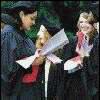 |
|
How Many Hairs on A Medium-sized Cat? 600 High School Students From Across Ontario to Engage in Science "Brainathlon", Grapple with Mind-teasing Questions During York U. Science Olympics
The York University Science Olympics offers high school students the opportunity to experience the challenge and excitement of working against the clock on various science-related events. At the end of the day, prizes will be awarded to the best three teams in each event, and a trophy will be presented to the school which is the overall winner. This year, approximately 600 students from more than 40 high schools across Ontario will gather at York's Keele Campus to participate in the following events:
Catapult: Teams will fire water-filled balloons from a giant catapult made by stretching rubber tubing between Žfootball' goalposts. Targets will be placed at various distances downrange on the field. (Location: York Common, York Blvd.)
Compounds: This event is played like the traditional ScrabbleTM game with letters of the alphabet replaced by chemical elements, radicals and multipliers written on cards. Each team, during its turn, accumulates points as it continues the chain of cards to form an "acceptable compound" (rather than an acceptable word, as in the usual game). The team with the highest score wins. (Location: Curtis Lecture Halls "A" and "E")
Bio-Steeplechase: Relay teams attempt to clear four hurdles in the fastest time possible. They clear them by answering four multiple choice questions in botany, zoology, biochemistry, genetics, molecular biology and ecology. The first team to answer all the questions correctly wins. (Location: Bethune College Dining Hall)
Fermi Questions: Teams will be required to give estimates to questions such as "How many hairs on a medium-sized cat?" (Location: Rooms 218-223, Stong College)
Water Rocket: Teams will strive for the longest duration water-rocket flight. A water rocket is a partially water-filled 2-litre plastic pop bottle which can be launched using a bicycle pump to heights in excess of 30 metres. (Location: field between Steacie Science Building and Farquharson Science Building)
WWW Scavenger Hunt: Teams will embark on a scavenger hunt on the web. Given a set of clues, they will follow links on the World Wide Web to some final destination. Along the way, they will have the opportunity to collect special ŽEaster eggs' (bonus points) that will be used in computing their score. (Location: Ariel Lab, room 160, Chemistry and Computer Science Building)
The York Science Olympics will begin at 8:30 a.m. in Curtis Lecture Hall "L". Teams will reassemble there for the closing ceremony and awarding of prizes at approximately 4:15 p.m. A schedule of event times and locations for each team will be given out at registration time.
York science professors will judge the events. If you have trouble finding any of the events, Professor Keith Aldridge, the coordinator of the Science Olympics, is available via cellular phone (416) 399-0124 throughout the day. The central meeting place for the York Science Olympics is Curtis Lecture Hall "L", through Vari Hall, off Central Square.
The York University Science Olympics is sponsored by Pasteur M»rieux Connaught and York University's Faculty of Pure and Applied Science. For a map of the York campus, please call the York media relations office at (416) 736-2100, ext. 22086, or visit: http://www.science.yorku.ca/olympics.
WHO: High School Students from 40 schools across Ontario
WHAT: 20th annual York University Science Olympics
WHEN: Friday, May 14, 1999, 8:30 a.m. - 4:30 p.m.
WHERE: Curtis Lecture Hall "L", York University, 4700 Keele Street
For more information, please contact:
Professor Keith Aldridge
Ken Turriff |
|
|
| | Welcome to York University | Latest Release | Release Archives | |
![[to York's Home Page]](../../images/yorklogos.gif)
